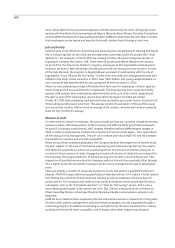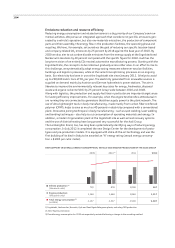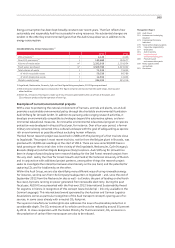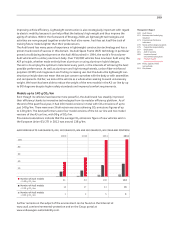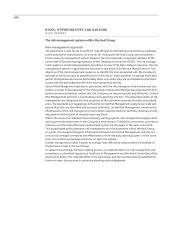Audi 2012 Annual Report Download - page 182
Download and view the complete annual report
Please find page 182 of the 2012 Audi annual report below. You can navigate through the pages in the report by either clicking on the pages listed below, or by using the keyword search tool below to find specific information within the annual report.
185
Management Report
140 Audi Group
151 Business and underlying
situation
173 Financial performance
indicators
176 Social and ecological aspects
176 Corporate responsibility
177 Employees
181 Audi in society
182 Location-based
environmental aspects
186 Product-based
environmental aspects
190 Risks, opportunities
and outlook
201 Disclaimer
Energy consumption has been kept broadly constant over recent years. That fact reflects how
sustainably and responsibly Audi has succeeded in using resources. No substantial changes are
evident in the other key environmental figures that the Audi Group observes in addition to its
energy consumption.
ENVIRONMENTAL STRUCTURAL DATA 1)
2012 2011
VOC emissions 2) t 2,149 2,340
Direct CO2 emissions 3) t 195,680 194,677
Volume of waste water m³ 2,292,910 2,159,854
Fresh water purchased m³ 3,569,786 3,323,962
Total volume of waste t71,933 72,832
of which recyclable waste t59,339 60,788
of which disposable waste t12,594 12,044
Metallic waste (scrap) t324,292 335,316
1) Ingolstadt, Neckarsulm, Brussels, Győr and Sant’Agata Bolognese plants; 2012 figures provisional
2) VOC emissions (volatile organic compounds): This figure comprises emissions from the paint shops, test rigs and
other facilities.
3) Direct CO2 emissions: This figure is made up of CO2 emissions generated by the use of fuel at the plant, and
CO2 emissions produced by the operation of test rigs.
Examples of current environmental projects
With a view to protecting the natural environment of humans, animals and plants, we at Audi
promote a sustainable environmental policy through the charitable environmental foundation
Audi Stiftung für Umwelt GmbH. In addition to pursuing wide-ranging research activities, it
develops environmentally compatible technologies beyond the automotive sphere, and envi-
ronmental educational measures. An innovative environmental educational program on species
protection was developed in the past fiscal year, for instance. Over a four-year period, a former
military site is being converted into a cultural landscape with the goal of safeguarding as species-
rich an environment as possible without excluding human influence.
The Oak Forest research project was launched in 2008 with the planting of a first trial site close
to Ingolstadt. The project’s most recent trial site, not far from the Belgian plant in Brussels, was
planted with 10,000 oak seedlings at the start of 2012. There are now some 90,000 trees in
total growing on the six trial sites in the vicinity of the Ingolstadt, Neckarsulm, Győr (Hungary),
Brussels (Belgium) and Sant’Agata Bolognese (Italy) locations. Audi Stiftung für Umwelt has
been in charge of providing long-term research backup for the Oak Forest research project from
the very start. Led by the Chair for Forest Growth and Yield at the Technical University of Munich
and in conjunction with additional project partners, among other things the research project
seeks to investigate the interaction between stand density on the one hand, and the potential for
capturing CO2 and for biodiversity on the other.
Within the Audi Group, we are also identifying many different ways of using renewable energy.
For instance, we ship cars from the Company headquarters in Ingolstadt – and, since the end of
September 2012 from the Neckarsulm site as well – to Emden, the port of loading on the North
Sea coast, by trains running on power generated from renewable electricity. During the past
fiscal year, AUDI AG was presented with the first-ever 2012 International Sustainability Award
for Logistics in Vienna in recognition of this concept (www.bvl.de/npl – link only available in the
German language). This international award sponsored by the Austrian and German Logistics
Associations comes as particular recognition of the Audi transport concept’s sparing use of re-
sources, in some cases already with a neutral CO2 footprint.
The supercar manufacturer Lamborghini also addresses the issue of sustainable production in
considerable depth. The CO2 emissions of its vehicles are thus to be reduced by around 35 percent
by 2015. In close cooperation with the Italian Ministry for the Environment, CO2 emissions in
the production of carbon fiber monocoques are also to be reduced.







